Clipstone Camp 1915 - 2015
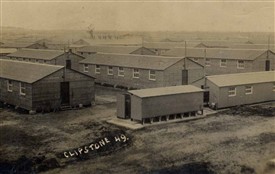
Early photo of Clipstone Camp
Private collection
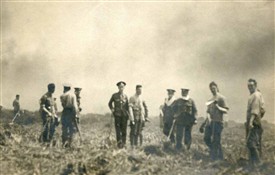
Soldiers helping with heath fires
Private collection
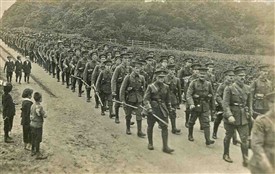
Watching the soldiers
Private collection
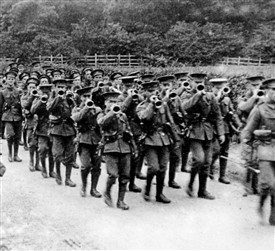
Music and marching
Private collection
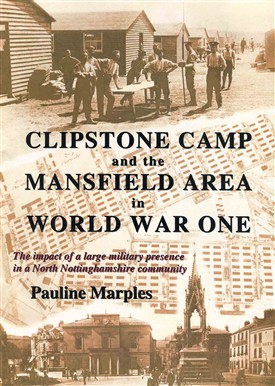
Book about Clipstone Camp, for details email heritage.foresttown@ntlworld.com
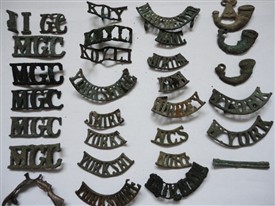
Shoulder titles etc
I & R Machin
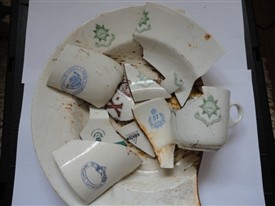
Regimental crockery
I & R Machin
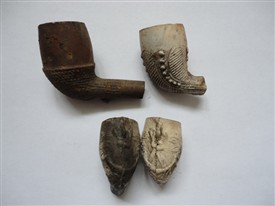
Clay pipes
I & R Machin
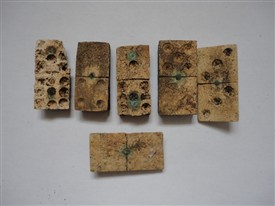
Dominoes - a soldiers past time
I & R Machin
When the soldiers came - What they left behind
By Pauline Marples
1915
Throughout the first months of 1915 a vast area of the moorland landscape near Clipstone was gradually changing as hundreds of wooden huts were erected. These were to accommodate soldiers of Kitcheners New Army who would live and train in the area for weeks, or even months, before moving on to participate in the Great War. This huge hutted complex was known as Clipstone Camp.
MAY 1915 - The first soldiers arrive
Five thousand men of the UPS Royal Fusiliers were the first troops posted to the new camp. They had previously been stationed at Woodcote, Epsom, in comfortable quarters with garden plots. The Fusiliers move to Clipstone, was not just a change of scenery but a transformation of their style of living. Their first impressions of the camp at Clipstone earned it the name 'Land of Chaos'
They arrived at Edwinstowe on the 12th May 1915 and had to march four miles in the rain and were ankle deep in mud. The camp that greeted them was still in the process of being built. Candles were the only means of illumination as electricity to the camp had not yet been supplied. One soldier wrote home "we have no lights, knives, forks or looking glass."
More and more troops gradually arrived and additional to their military training some found themselves helping to prepare parade grounds etc., at the camp. Others found they were needed to help put out fires when the heather caught fire on land adjacent to the camp.
Clipstone Camp was a regular feature in the local newspapers. Readers were kept aware of the arrival of the soldiers such as the following headlines:
'More Battalions Come in' - 'Arrival of the 16th Kings Royal Rifles' - 'Footballers Battalion Arrives'
The newspapers also revealed the lack of huts to accommodate all the soldiers. The Notts Evening Post 10 July - 'The Khakie stream continues to flow to Clipstone, several more battalions have arrived during the week. On Wednesday over 1,000 men of the ASC [Army Service Corps] came along and have gone under canvas. Some of them are quartered close to Sherwood Hall, others have passed to the new camp at Rufford and the remainder have a triangular piece of land at the entrance to the Dukes Drive at Clipstone'.
1915 - 1920
With upwards of 30,000 soldiers at Clipstone Camp at any one time the total number of soldiers who were there during those years is unknown What is known is the impact it had on the people and communities of Mansfield and area. Much of this can be discovered in the book 'Clipstone Camp and the Mansfield Area in World War One' (details from heritage.foresttown@ntlworld.com or see the Books for Sale page on this web site).
Soldiers both training and marching were a regular sight for miles around.
2015
One hundred years on [2015] the land which was once covered with hundreds of wooden army huts is now virtually a mass of housing estates, schools and other local amenities. Visually there is nothing to tell you it was once one of the biggest military training camps, and demob camp in the country Only the very enthusiastic historians can still discover artefacts that the soldiers have left behind, (see the examples), or the remnants of trenches that soldiers dug and trained in.
However interest in Clipstone Camp is growing as more people like myself continue to do research. New information is being discovered all the time from various sources, and as more records are digitised and put on the internet.
The centenary of the start of the Great War in 2014 encouraged a new awareness and enthusiasm of local and military history. Students at Garibaldi College (built on the site of Clipstone Camp) have for the past months been working on an exhibition 'Lest We Forget' which is on display in Mansfield Museum throughout May 2015. Sherwood Pine Forest, near Clipstone, has an ongoing project relating to Clipstone Camp and the First World War Trenches. 'WW1 Clipstone Camp' can be found on Face Book where people can add information/comments.
The www.ournottinghamshire.org.uk and www.ourmansfieldandarea.org.uk web sites both have pages relating to Clipstone Camp with facilities to add comments and expand the knowledge about the camp and the people who were there. As 2015 progresses it is anticipated information on these web site will continue to grow - keep visiting and 'watch this space'.